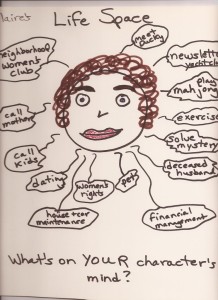Talking about the state of the publishing industry can be depressing these days, so let’s go back to why we write in the first place: We love storytelling. Many of us use visual tools when we write: collages about the main character or setting, plotting diagrams, charts, timelines, and photos. I’m just as guilty as the next writer in this regard. So here are some of the favorite ones I use, and I hope you’ll share what works for you.
PHOTOS
This is the most fun. I keep a file with pictures of people I cut out from TV Guide, Entertainment Weekly, and other magazines. Then when I’m planning a novel and doing my character development, I’ll search through the pages to find the one person who looks just like my character. I used to staple these onto my character development sheets, but now I scan them into the computer and add them to my file on that person. Looking for the villain is even more fun. I’m especially fond of sneaky looking people. Perfect models won’t do. You want these profiles to be interesting and tell you something about the character. For a mystery, I’ll do the sleuth for the first book in the series, some of the continuing characters, and the suspects for each installment.
PLOTTING BOARDS
In the planning stages of a story, I’ll divide a poster board into the number of chapters I plan to fill my book and then I’ll stick Post-It notes on the poster scribbled with different plot points. This helps me see the story flow before I write the synopsis. Later, I’ll fill in the squares with ink after I’ve written the chapter. Thanks to Barbara Parker who taught me this trick, I use different colored inks for the main plotline, loose ends, clues leading to the killer, and new characters on stage.
TIMELINES
It often becomes necessary to draw a family tree. I haven’t found an easy way to do this on the computer and manage with Word. Also, when I have to calculate characters’ ages, this is where they go.
LIFE SPACE
This helps you get into the head of your character. Draw a head on a blank sheet of white paper and put your person’s name in it. Then draw cartoon-like balloons all around the head. Inside these spaces, write in what’s on your character’s mind at any given point in time. Solving a murder? Taking mother to lunch? Picking up laundry? Calling boyfriend? How many concerns are on your mind right now? Ask your character what she’s thinking about. Here’s an example from my current WIP (an artist, I am not!).
These are some of the visual aids I build when writing a story. Now let’s hear what you do.

